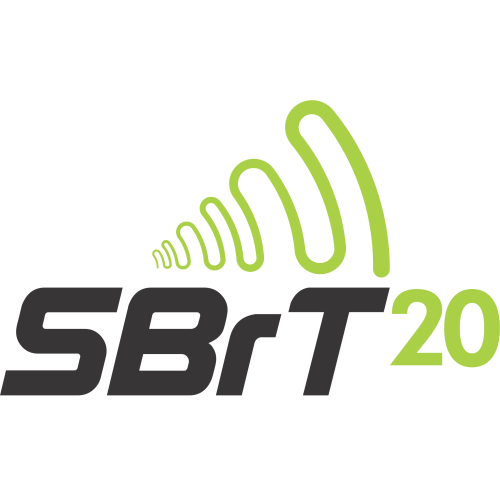
XXXVIII Simpósio Brasileiro de Telecomunicações e Processamento de Sinais
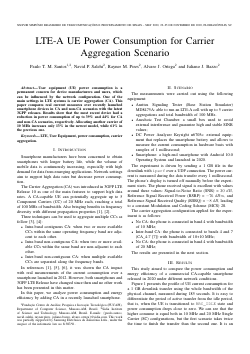
LTE-A UE Power Consumption for Carrier Aggregation Scenario
Paulo T. M. Santos, Navid Portela Salehi, Rayner M. Pires, Alvaro Ortega, Juliano Bazzo
DOI: 10.14209/SBRT.2020.1570661121
Keywords: LTE User Equipment Power Consumption Carrier Aggregation.
Abstract
User equipment (UE) power consumption is a permanent concern for device manufacturers and users, which can be influenced by the network configuration. One of the main settings in LTE systems is carrier aggregation (CA). This paper compares real current measures over recently launched smartphone devices in CA and non-CA scenarios with the latest 3GPP releases. Results show that the most recent device had a reduction in power consumption of up to 39% and 44% for CA and non-CA scenarios, respectively. Allocating another carrier of 10 MHz increases only 13% in the newest model, while 61% in the previous one.Download

IoT-DFR³: Explorando a Geração Dinâmica de Regras Fuzzy para Classificação de Recursos na IoT
Patrick Fernandes, Renato Dilli, Carlos Vinicius Machado Silva, Renata Reiser, Adenauer Yamim
DOI: 10.14209/SBRT.2020.1570661193
Keywords: Geração de Regras Fuzzy Classificação de Recursos Internet das Coisas Lógica Fuzzy Tipo-2
Abstract
Com o crescente número de recursos na IoT, surge o desafio de selecionar o recurso disponível que ofereça melhor Qualidade de Serviço (QoS) ao cliente, considerando suas preferências. Este trabalho tem como objetivo a concepção da proposta IoT-DFR³, que contempla: (i) emprego de Lógica Fuzzy Tipo-2 Intervalar para tratamento de incertezas na definição dos atributos de QoS; (ii) geração dinâmica de Regras Fuzzy, explorando o método de Wang-Mendel; e (iii) tradução das preferências dos clientes em regras Fuzzy. Além disso, um cenário de uso, comparando a classificação de recursos, aplicando diferentes preferências de cliente é apresentado.Download
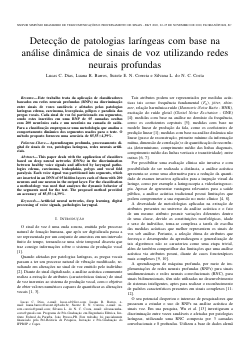
Detecção de patologias laríngeas com base na análise dinâmica de sinais de voz utilizando redes neurais profundas
Lucas Cardoso Dias, Luana Rodrigues Barros, Suzete Correia, Silvana Cunha Costa
DOI: 10.14209/SBRT.2020.1570661237
Keywords: Aprendizagem profunda Processamento digital de sinais de voz Patologias laríngeas Redes neurais artificiais
Abstract
This paper deals with the application of classifiers based on deep neural networks (DNNs) in the discrimination between healthy voice signals and affected by laryngeal pathologies edema, carcinoma, leukoplakia, polyps and vocal fold paralysis. Each voice signal was partitioned into segments, which are inserted in an DNN of 05 hidden layers with 200 neurons and one neuron in the output layer. For the classification a methodology was used that analyzes the dynamic behavior of the segments used for the test. The proposed method provided an accuracy of 85,55±4,39%Download
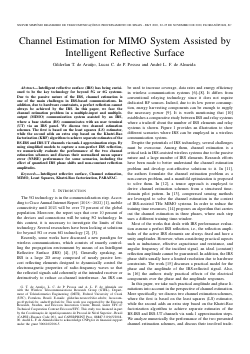
Channel Estimation for MIMO System Assisted by Intelligent Reflective Surface
Gilderlan Tavares de Araújo, Lucas Campos de Paula Pessoa, André de Almeida
DOI: 10.14209/SBRT.2020.1570661259
Keywords: Intelligent Reflective Surface Channel Estimation MIMO Khatri-Rao Factorization
Abstract
Intelligent reflective surface (IRS) has being envisioned to be the key technology for beyond 5G or 6G systems. Due to the passive nature of the IRS, channel estimation is one of the main challenges in IRS-based communications. In addition, due to hardware constraints, a perfect reflection cannot always be achieved by the IRS. In this paper, we face the channel estimation problem in a multiple-input and multiple-output (MIMO) communication system assisted by an IRS, where a base station (BS) communicates with an user terminal (UT) via an IRS panel. We discuss two channel estimation schemes. The first is based on the least squares (LS) estimator, while the second adds an extra step based on the Khatri-Rao factorization (KRF) algorithm to achieve separate estimates of the BS-IRS and IRS-UT channels via rank-1 approximation steps. By using simplified models to capture a non-perfect IRS reflection, we numerically evaluate the performance of the two channel estimation schemes and discuss their normalized mean square error (NMSE) performance for some scenarios, including the effect of quantized IRS phase shifts and non-constant reflection amplitudes.Download
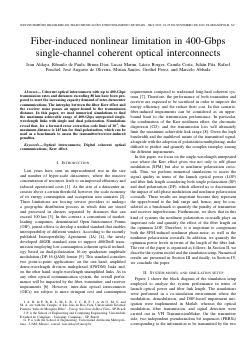
Fiber-induced nonlinear limitation in 400-Gbps single-channel coherent optical interconnects
Ivan A Aldaya, Rômulo de Paula, Bruna Dias Pires de Souza, Lucas Marim, Lucio Borges, Julián Pita, Rafael Abrantes Penchel, Jose de Oliveira, Mrian Santos, Gretell Perez, Marcelo Abbade, Camila Costa
DOI: 10.14209/SBRT.2020.1570661342
Keywords: Inter-datacenter communications Digital coherent optical systems Nonlinear phase noise
Abstract
Coherent optical interconnects with up to 400-Gbps transmission rates and distances exceeding 80 km have been proposed to meet the increasing capacity demand of inter-datacenter communications. The interplay between the fiber Kerr effect and the receiver noise posses an upper-bound to the transmission distance. In this paper, we used numerical simulations to find the maximum achievable range of 400-Gbps unrepeated single-wavelength links with single and dual polarization. Simulations reveal that, for a forward error correction code limit of 10-3, the maximum distance is 145 km for dual-polarization, which can be used as a benchmark to assess the transmitter/receiver-induced penalties.Download
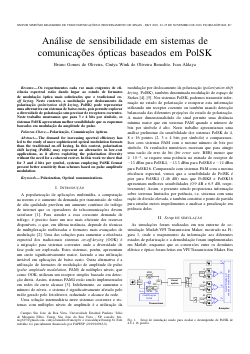
Análise de sensibilidade em sistemas de comunicações ópticas baseados em PolSK
Bruno de Oliveira, Cintya W. O. Benedito, Ivan A Aldaya
DOI: 10.14209/SBRT.2020.1570661347
Keywords: Comunicações ópticas Modulação de polarização Polarimetria
Abstract
Os requerimentos cada vez mais exigentes de eficiência espectral estão dando lugar ao estudo de formatos de modulação óptica mais sofisticados que o tradicional on-off keying. Neste contexto, a modulação por deslocamento da polarização (polarization shift keying, PolSK) pode representar uma alternativa em sistemas de baixo custo, pois permite explorar a diversidade de polarização sem precisar de receptores coerentes. Neste trabalho mostramos que para 3 e 4 bits por símbolo, os sistemas PolSK apresentam melhor sensibilidade que os esquemas baseados em modulação da amplitude do pulso.Download
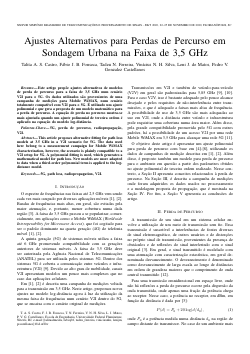
Ajustes Alternativos para Perdas de Percurso em Sondagem Urbana na Faixa de 3,5 GHz
Talita Castro, Fábio Fonseca, Tadeu Ferreira, Vinicius Nunes Henrique Silva, Leni Matos, Pedro Gonzalez Castellanos
DOI: 10.14209/SBRT.2020.1570661353
Keywords: 5G perda de percurso radiopropagação V2I
Abstract
This article proposes alternative fitting for path loss models at 3.5 GHz in a V2I scenario for 5G. The data used here belong to a measurement campaign for Mobile WiMAX characterization, however, the scenario is plainly compatible to a V2I setup for 5G. A polynomial fitting is used, which generates a mathematical model for path loss. New models are more adapted to data when a third-order polynomial term is applied to the log-distance model.Download
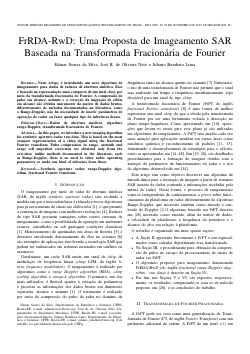
FrRDA-RwD: Uma Proposta de Imageamento SAR Baseada na Transformada Fracionária de Fourier
Edmar da Silva, José R. de Oliveira Neto, Juliano B. Lima
DOI: 10.14209/SBRT.2020.1570661408
Keywords: radar de abertura sintética algoritmo range-Doppler transformada fracionária de Fourier
Abstract
In this paper, we introduce a new imaging algorithm for synthetic aperture radar raw-data. This is based on the most compact representation of a chirp signal using the fractional Fourier transform. Pulse compression in range, azimuth and range cell migration correction are obtained only from the rawdata, unlike methods documented in the literature, there is no need to enter radar operating parameters [1] or make any kind of inference from those [2, 3].Download
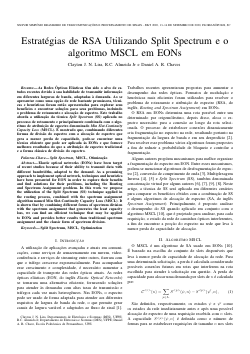
Estratégias de RSA Utilizando Split Spectrum e o algoritmo MSCL em EONs
Clayton J. N Lira, Daniel Chaves, Raul C. Almeida Jr
DOI: 10.14209/SBRT.2020.1570661412
Keywords: Split Spectrum MSCL Otimização
Abstract
Elastic optical networks (EONs) have been target of recent studies because of their ability to transmit data with different bandwidths, adapted to the demand. As a promising approach to implement optical network, techniques and heuristics have been presented for EON in order to explore their benefits and find solutions for their problems, including the Routing and Spectrum Assignment problem. In this work we propose the utilization of the Split Spectrum (SS) technique applied in the routing process, combined with the spectrum assignment algorithm named Min Slot-Continuity Capacity Loss (MSCL). It is shown that by combining different forms of spectrum division with the spectrum assignment that generates the least capacity loss, we can find an efficient technique that may be applied to EONs and provides better results than traditional spectrum assignment and the classic form of spectrum division.Download
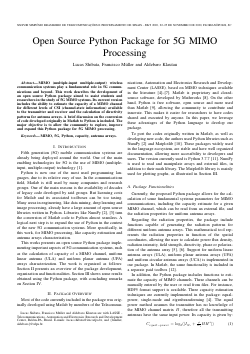
Open Source Python Package for 5G MIMO Processing
Lucas C Shibata, Francisco C. B. F. Müller, Aldebaro Klautau
DOI: 10.14209/SBRT.2020.1570661423
Keywords:
Abstract
MIMO (multiple-input multiple-output) wireless communication systems play a fundamental role in 5G communications and beyond. This work describes the development of an open source Python library aimed to assist students and researchers in the study of 5G MIMO systems. Its current version includes the ability to estimate the capacity of a MIMO channel for different levels of CSI (channel-state information) available to the transmitter and receiver and the calculation of directivity patterns for antenna arrays. A brief discussion on the conversion of code developed originally in Matlab to Python is included. The major objective is to allow the community to explore, improve and expand this Python package for 5G MIMO processing.Download